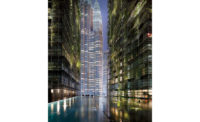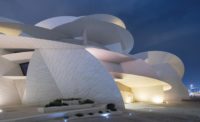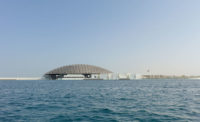Fondazione Alda Fendi - Esperimenti by Jean Nouvel
Rome

The new foundation headquarters occupies three historic apartment buildings near the Arch of Janus.
Photo © Roland Halbe

The architects inserted steel framing for lintels, pillars, doors, and stairs in the atrium.
Photo © Roland Halbe

Stainless-steel kitchen and bathroom fit-outs were inserted to provide a striking contrast to mottled walls.
Photo © Gionata Xerra

Inside the individual residences, the architects printed photographic images on movable window screens, showing glimpses of the apartments before the renovation. Sections of original floor tiles were left untouched but surrounded by new materials.
Photo © Gionata Xerra

Photo © Roland Halbe

Photo © Roland Halbe

Photo © James Reginato

Photo © James Reginato

Photo © James Reginato

Photo © James Reginato

Photo © James Reginato

Photo © James Reginato

Photo © Ateliers Jean Nouvel

Photo © Ateliers Jean Nouvel

Photo © Ateliers Jean Nouvel

Photo © Ateliers Jean Nouvel

Image courtesy Ateliers Jean Nouvel

Image courtesy Ateliers Jean Nouvel


















Architects & Firms
Jean Nouvel’s first project in Rome—the new headquarters of the multidisciplinary arts organization Fondazione Alda Fendi - Esperimenti—is in Velabro, the quarter where the mythic baby twins Romulus and Remus, who founded the city, were supposedly discovered in a basket on a bank of the Tiber. The building is adjacent to the Arch of Janus, not far from the Imperial Fora.
Nouvel created the six-story, 38,000-square-foot complex, called Rhinoceros—whose name alludes to the resin statue that sits outside the building, symbolizing the power of Rome’s imperial history—out of three contiguous apartment buildings. Erected between the 17th and 19th centuries, the structures were in a parlous state when the foundation, started by Alda Fendi, acquired them. Nouvel was selected for his “very strong approach,” says Fendi, which is “hard, sometimes. But at the same time, he is very respectful of history and has very poetic spirit.”
Fendi created her foundation, which aims to break down barriers between art, theater, literature, music, and performance, after the fashion powerhouse established by her parents was sold to luxury-goods group LVMH in 2001. The organization has mounted many provocative, avant-garde happenings in its previous home, at the Palazzo Roccagiovine, above the Forum of Trajan, and at other locations in Rome. In this new setting, which Nouvel describes as an “artists’ village,” Fendi also initiated a partnership to exhibit work loaned by the Hermitage Museum.
In addition to galleries and shops, which will open at a later date, the building houses a 24-suite hotel, operated by Spanish hotelier Kike Sarasola, called the Rooms of Rome, and a rooftop branch of Paris’s Caviar Kaspia restaurant, with terraces offering dazzling views of ancient Rome. “It’s a neighborhood under one roof,” says Fendi. “A place for living with art.”
Since the facades are listed as landmarks, Nouvel preserved many elements while giving the building a “new lease of life that is electrifying,” he says. Inside, the architect added steel framing for lintels, pillars, and stairs. For the hotel rooms, he had more leeway to express himself; each apartment, he says, “is a separate project.” While he retained many original fragments of tile and mottled stone, the architect inserted stainless-steel blocks containing kitchens and bathrooms to function as sleek objects in space. Contrasts don’t stop: the interiors of the movable window screens are covered with photo prints showing what the apartments looked like before the renovation began, and new furnishings encompass a variety of custom items as well as highlights of Italian design, such as Castiglioni lights.
Visiting or staying in the Rhinoceros, you feel steeped in antiquity while belonging to the moment—an invigorating and inspiring experience. Says Nouvel, “It’s a play of encounters, a collision of epochs from the most ancient to the most modern.”
Photographic images on movable window screens show glimpses of the apartments before the renovation.





